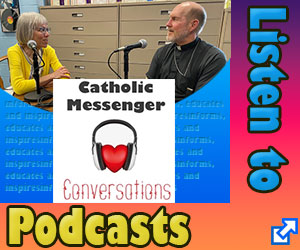
By Judith Costello
I was 14 years old, walking home from school beneath a heavy sky. I had been asked to give a talk about prayer to a group of my peers.
That thought was making me sweat despite the cool weather. I talked to God in my head, muttering a little bit out loud as I walked along the path. When I came to the top of a hill, the clouds overhead parted. A single ray of light came down making the sidewalk right in front of me glisten. It seemed to me this was a clear message that God was with me and all would be well. I felt quite sure of it.
So I told the teen group, “Prayer isn’t a formula. You don’t have to memorize old prayers or study about it. It’s a conversation. Just start talking and leave space occasionally for God to answer back.”
I was a bit cocky about prayer after that. I thought I had it figured out. It took years of life experience to learn that the moment the sky opened was an invitation to go deeper in study. There’s a lot to learn about prayer AND the effort of learning about it is an exciting adventure.
For the past three years I’ve been studying with the Third Order of Discalced Carmelites. The youthful enthusiasm that led me to plead with other teens has returned and I want to tell everyone, “Learn how to talk to God. He’s listening and he’s waiting.”
I know that it’s good to start with “just talking,” but it’s also good to keep a perspective on just who we are talking to and remember that prayer is like learning a different language. Just as it’s worthwhile to learn Spanish if you’re going to Mexico, it’s also worth learning the language of prayer if we’re heading for heaven.
I tell my animal-loving kids that it’s a bit like talking to animals. You may really want the horse or the eagle to understand you. You may long to have a deep relationship. But if that’s as far as it goes — just wishing and talking out loud in the way you talk to a buddy — the project won’t go very far. You have to add observation, dedication and study. Then the talk will deepen because it becomes a form of communication built on understanding.
The animal analogy is limited of course. We talk to animals in order to have some control over them. When we talk to God our goal is to invite him to take control, working through us.
We have an amazing model for this journey. God came to earth in a human form. He showed us that we should talk freely to our Father. We can state our fears and longings. But then the important next step is surrender. And this happens when we understand more about him and we have trust in him.
That’s the part I didn’t get as a teen. I didn’t understand that when the sky opens up and the presence of God is felt, it’s time to invite a complete “takeover.” To say, “Not my will but thy will be done.”
Prayer is conversation. But it’s like reaching out to that big, beautiful, sometimes elusive horse, saying, “Please be my friend.” If we don’t understand what he expects, or how he moves in our world, the contact we long for won’t happen.
Yet, God reaches down to us and waits lovingly for us to learn the language of prayer.
(Judith Costello is a freelance writer who grew up in Davenport and now lives in rural New Mexico. Her Web site is www.thedailychristian.com.)








